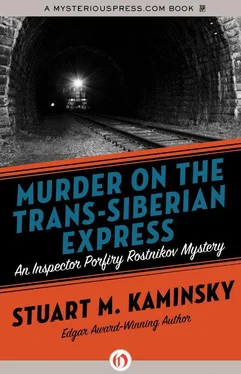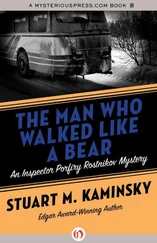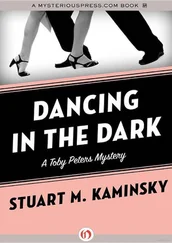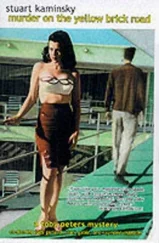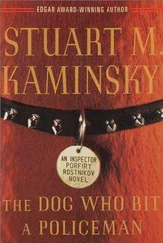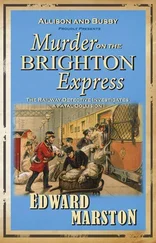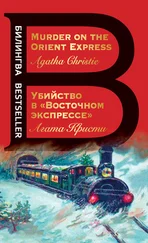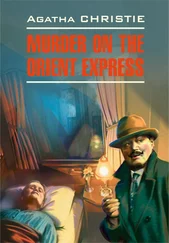Stuart Kaminsky - Murder on the Trans-Siberian Express
Здесь есть возможность читать онлайн «Stuart Kaminsky - Murder on the Trans-Siberian Express» весь текст электронной книги совершенно бесплатно (целиком полную версию без сокращений). В некоторых случаях можно слушать аудио, скачать через торрент в формате fb2 и присутствует краткое содержание. Год выпуска: 2012, Жанр: Полицейский детектив, на английском языке. Описание произведения, (предисловие) а так же отзывы посетителей доступны на портале библиотеки ЛибКат.
- Название:Murder on the Trans-Siberian Express
- Автор:
- Жанр:
- Год:2012
- ISBN:нет данных
- Рейтинг книги:3 / 5. Голосов: 1
-
Избранное:Добавить в избранное
- Отзывы:
-
Ваша оценка:
- 60
- 1
- 2
- 3
- 4
- 5
Murder on the Trans-Siberian Express: краткое содержание, описание и аннотация
Предлагаем к чтению аннотацию, описание, краткое содержание или предисловие (зависит от того, что написал сам автор книги «Murder on the Trans-Siberian Express»). Если вы не нашли необходимую информацию о книге — напишите в комментариях, мы постараемся отыскать её.
Murder on the Trans-Siberian Express — читать онлайн бесплатно полную книгу (весь текст) целиком
Ниже представлен текст книги, разбитый по страницам. Система сохранения места последней прочитанной страницы, позволяет с удобством читать онлайн бесплатно книгу «Murder on the Trans-Siberian Express», без необходимости каждый раз заново искать на чём Вы остановились. Поставьте закладку, и сможете в любой момент перейти на страницу, на которой закончили чтение.
Интервал:
Закладка:
Rostnikov and Sasha sat silently, Porfiry Petrovich in front with the driver, Sasha in back. They all watched the snow. The driver checked his dashboard clock from time to time. He was determined to meet the challenge.
Ten minutes before the train was due to depart, the unmarked police car pulled into the broad drop-off area in Komsomolskaya Square in front of the train station. He maneuvered through cars, hotel vans, tourist coaches, green cabs and yellow cabs to get the policemen to the doors of the station.
Lights filtered through the snow. The dark top of the station with two windows over the arch looked like the hood of an ancient hangman.
Five minutes later, Sasha Tkach and Porfiry Petrovich Rostnikov waited in line to board the Trans-Siberian Express. There were five people ahead of them, a couple and their small child, a boy. The father was wrestling two suitcases up the steps of the train. Behind him, trying to protect her son from the frustrated flailing of her husband, the woman held the boy’s hand and led him cautiously up the steps. Directly in front of Sasha and Porfiry Petrovich were two old men talking in English. Finally, Rostnikov climbed the metal steps with a minimum of awkwardness and the help of his left arm. The right was occupied with his suitcase.
If they had to go all the way to Vladivostok, it would be seven days, six nights, more than four thousand miles. It could be a long trip.
Part II
Chapter One
Life on earth is short at best
The cities are a game of chess
Copper domes and statuettes
Victories with marble breasts
Leave the burden with the rest
Watch the sleepers phosphoresce
Trans-Siberian Express
There were eighteen carriages in the train, plus a dining car. The narrow corridors of the carriages were crowded. Sweat, grunts, hurrying, pushing. Languages. English, French, German, Chinese. Faces to match the languages. Some laughter. The shrill voice of a woman in Russian asking, “Petrov, are you behind me?” Petrov answered above the crowd and the awakening sounds of the train engine.
In 1857, N.N. Murav’ew-Amurski, governor of eastern Siberia, commissioned a military engineer named Romanov to explore the possibility of a railroad to connect Siberian cities to each other and the western metropolises, including St. Petersburg and Moscow. Romanov came up with a plan. The Russian government gave it no support till the czar became interested in the possibility of such an enterprise in 1885. Entrepreneurs from Germany, France, Japan, and England came forward with offers of help, but Czar Alexander III feared strengthening foreign influence in eastern Russia and decided to use government money for the project. In 1886, Czar Alexander approved a report from the governor of Irkutsk in Siberia.
The czar wrote: “I have read so many reports from the Siberian governors that now I can admit with sadness that the government did almost nothing to meet the needs of this rich, neglected region. It is time to correct that error.”
In 1887, three expeditions were launched, each headed by an engineer appointed by the czar. One expedition was to find a path to Zabaikalskaya, another to explore the construction possibilities through middle Siberia, and the third to examine the feasibility for a connection to the South-Ussuriyskaya railroads. Following the expeditions, the czar appointed a Siberian Railroad Construction Committee, which declared that the “Siberian railroad construction is a great national event which should be built by Russian people using Russian material.”
Rostnikov searched for his compartment. Most passengers were already stowing their bags in the compartments designed for four people. Western tourist agencies booked their clients together, four Frenchmen in a compartment, four Americans in another. But a compartment of Russians could be next to one with four Chinese or Americans, and a woman traveling alone might find herself in a compartment with three men. And another car might be filled with Russians, except for one with four Greeks. Sometimes tourists going nowhere but on a train ride asked to be placed in a compartment with Russians.
When Rostnikov found his compartment, he was greeted by a reasonably polite conductor, who said, “Your ticket.”
Rostnikov handed the ticket to the man, who took it and gave him another.
“You have been switched to the next compartment, thirty-one.”
Rosţnikov did not bother to ask the reason since the compartment was nearby and he knew there could be a dozen good reasons for the move or a dozen bad ones. The conductor probably did not even know.
So, whether by design or chance, Rostnikov found himself wedging into a compartment where three men sat speaking English. There was a small white table next to the window of the compartment. A bottle of vodka sat on it with glasses. The men had the tentative air of people who were getting acquainted.
“Excuse me,” Rostnikov said in English, lifting his suitcase toward the high luggage rack. The three men, two who appeared to be in their seventies and one who might be fifty, nodded at him. The slightly rotund youngest man said, “Welcome. Need some help with that?”
Rostnikov recognized the old men as the two who had boarded the train in front of himself and Sasha.
“I am able to manage,” Rostnikov answered. “Thank you.”
“A glass of vodka to toast our journey and new friends?” said one of the men.
Rostnikov finished stowing the suitcase and accepted the offered glass.
“Zah vahsheh zdahrov yeh ee blahgahpahlooch’yeh, health and happiness,” said the man who had handed Rostnikov his glass.
Rostnikov repeated the toast and touched his glass to those held out by the three men. And then he drank.
After receiving the report of the committee, Alexander III wrote a directive to his son, Czarevitch Nikolya Alexandrovitch, stating: “I order the start of construction of a continuous railroad across all of Siberia. I want to connect Siberian regions rich in natural resources with the rest of the Russian railroad system. This is my will. I want you to use the funds of the Russian treasury to complete this historic enterprise.”
On May 19, 1891, at ten in the morning, the first religious ceremony to bless the new project was held at the foundation of what was to become the Vladivostok station. Czarevitch Nikolya Alexandrovitch, the future czar, was present and laid the first stone and a silver plate designed in St. Petersburg and personally approved by the emperor, Alexander III, himself. Construction had officially begun on the railroad that would twenty-five years later transport the future czar and his family to their death.
Rostnikov learned the names of the men who introduced themselves. One, a tall, lean. American who looked a bit like a very old Gary Cooper, shook Rostnikov’s hand and said his name was Robert Allberry.
“And this is Jim Susman,” Allberry said, nodding at a short man with a freckled bald head with a thatch of gray-white hair.
“And this,” Allberry said, nodding at the youngest man, “is David Drovny. I say that right?”
“David Drovny,” the youngest man said, offering his hand.
Drovny had the chest and build of an opera singer. He was heavy, on the verge of fat. The roundness of his face was given some line by his close-trimmed dark beard and mustache.
Most of the Trans-Siberian Railroad was built in nearly impossible weather over minimally populated or nonpopulated forest land. The roadbed had to go across strong Siberian rivers, around or over dozens of lakes, through swamps and permafrost. The most difficult section was around Baikal and Lake Baikal. Rocks had to be blasted to build tunnels and supporting structures and bridges.
Читать дальшеИнтервал:
Закладка:
Похожие книги на «Murder on the Trans-Siberian Express»
Представляем Вашему вниманию похожие книги на «Murder on the Trans-Siberian Express» списком для выбора. Мы отобрали схожую по названию и смыслу литературу в надежде предоставить читателям больше вариантов отыскать новые, интересные, ещё непрочитанные произведения.
Обсуждение, отзывы о книге «Murder on the Trans-Siberian Express» и просто собственные мнения читателей. Оставьте ваши комментарии, напишите, что Вы думаете о произведении, его смысле или главных героях. Укажите что конкретно понравилось, а что нет, и почему Вы так считаете.
